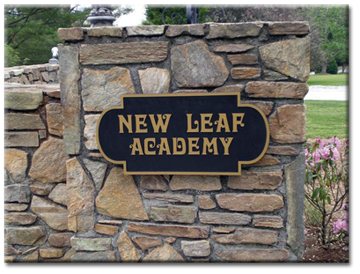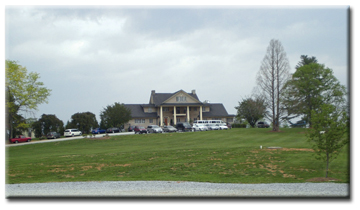| From Strugglingteens.com Visit Reports Hendersonville, North Carolina
Founded in 2005, and located in an impressive mansion on the top of a hill, this Junior Boarding School for girls overlooks their 50-acre campus that emphasizes natural beauty. Girls enrolled at New Leaf Academy of North Carolina are between the ages of 10 and 14. The 18- to 24-month program works with families to help girls work through issues surrounding growing up. Most of the girls' activities take place within the mansion. The exception being classes held in temporary buildings in the back, and of course off campus sports, recreational activities, an Equine component and volunteer work in the community for those late in the program. Living quarters, groups, dance lessons and socializing take place primarily in the mansion, where there is plenty of room for the 58 girls who were there during my visit. Turning into the driveway entering the school property, the view of the school above on the top of the hill is somewhat reminiscent of Scarlett O'Hara approaching her plantation Tara in Gone With the Wind. I'm sure that any girl enrolled, even somewhat aware of her surroundings, was amazed at the first sight of her future school. The girls I saw, however, seemed to have adjusted well and have taken it in stride that this is their school. This impression continues when entering through the huge double doors with the first inside view being cathedral type ceilings and a winding staircase leading up.
After a brief orientation by staff, two girls were assigned to give me a tour. Both had been in the program for some time and they were open and very helpful, chatting about their experiences at the school and plans for the future as we explored many of the nooks and crannies of the facility. To me, they appeared pretty much like normal early teen girls with more maturity and social skills than you would find in a typical girl of that age. After the tour, I was advised that one of them had come there with an Asperger's diagnosis. She must have progressed a long way at the school because I hadn't been able to detect that she suffered from that disorder. Their bedrooms were neat and clean, with the usual variation of some girl's personal space being homey with pictures and stuffed animals on and near their beds, and others being a little more sparse, indicating roughly the length of time the girl had been at the school. The rest of the building was clean and comfortable, also at least partly due to the girls taking on responsibility for the appearance of their home. Staff explained to me that an underlying focus is to teach the girls new ways to communicate, and give them the tools they need to improve communication. They explain there are three steps in this:
Academics are at the heart of the school. They follow a traditional academic curriculum and schedule, with challenging classes and typically about 8 to 10 students to a class. The personal development aspects are well integrated into the classroom as well as into the rest of the curriculum of physical development, recreation, responsibility and accountability. Upon enrollment, the girls enter the first phase called the Sun Circle, which averages six months in length. This is largely an orientation to the boundaries and expectations of the school and learning how to be part of the school community. Part of this phase is the initial development of a formal Individual Academic Plan (IAP). Staff explained this was basically the same as an Individual Education Plan (IEP), but without government involvement. The IAP helps determine what areas a student needs to work on, including emotional immaturity issues as well as academic strengths and weaknesses. The two major tools used in this assessment are the Stanford Achievement Test Series Edition 10, and STAR Assessment, of course along with staff observations. The students take these assessment tools upon enrolling at the school, and multiple times throughout their stay to mark progress. Staff explained to me that the school had been quite successful in getting public school districts to pay the tuition even without a specific IEP, which is usually required for school district funding. The IAP and the other formal assessment tools have been sufficient for school districts. The next phase, lasting approximately six months, is the Moon Circle. Here, students focus on relationships with parents and siblings and assume responsibility for their own personal growth. It is during this phase that personal learning style is investigated and assessed, and students work on the ability to form healthy relationships. As the girls work on family relationships, there is an emphasis to the parents as well as the children on learning and working with the progression of child growth and development. Family work is intensified in this phase. The Star Circle is the third approximately six-month phase. Each girl takes what she has learned in the previous year and applies that to leadership skills. She also applies what she learned to help in the school community as well as through volunteer work outside the school. She works on handling complex responsibilities and demonstrating appropriate social skills. Home visits are regularly scheduled during weeklong academic breaks as the girl and her family plan for the future, both for graduation and life after graduation. All in all, School Director Cat Jennings and her staff have put together an impressive program. © Copyright 2012 by Woodbury Reports, Inc. |

